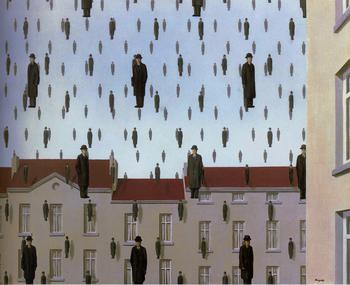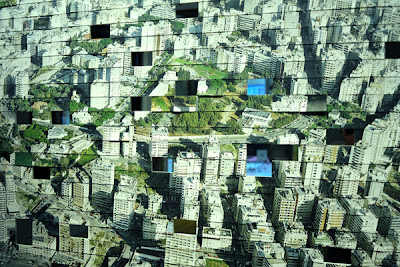 |
| "You never left", Youssef Nabil, 2011 |
"There is a beauty in the world, though it's harsher than we expect it to be." -Michael Cunningham, The Hours
"He would be back from India one of these days, June or July, she forgot which, for his letters were awfully dull; it was his sayings one remembered; his eyes, his pocket-knife, his smile, his grumpiness and, when millions of things had utterly vanished --how strange it was! --a few sayings like this about cabbages." -Virginia Woolf, Mrs. Dalloway.
Beautiful things. They were. They still were. Beautiful. Beautiful, as it were. There is always a first day. There was a first day. The beginning of everything, of all things, of the world. An ordinary morning, like any other morning in your life. But. "What I wanted to do seemed simple. I wanted something alive and shocking enough that it could be a morning in somebody's life. The most ordinary morning. Imagine, trying to do that." And what is a beginning, really, in a morning, just like that? "In the beginning, there is an end. Don't be afraid: it's your death that is dying. Then: all the beginnings. When you have come to an end, only then can Beginning come to you." He remembered that morning, he was in bed. They drove to the middle of nowhere, and just talked, for an entire night with all its hours, under the perfect warmth of summer, as if in the most total wakefulness. Someone talked about sighting a comet. That was an important detail, he thought. And yet nothing had changed, it was still, it was still just like that. The letters still tiptoed around the throat without making the slightest noise; imperceptible, delicate motions. So delicate that feeling anything at all seemed threatening, impossible, and dangerous. It was so difficult. Difficult to achieve that. The most ordinary morning in anybody's life. "What a thrill, what a shock, to be alive on a morning in June, prosperous, almost scandalously privileged, with a simple errand to run."
Some things. They have. They have already vanished. Tangible and predictable. The words are not important; it is things that matter most. Events. A certain manner of observing other things, and people. The conversations were unimportant too, and so were the letters. Many of them. He would have wanted to paint. Writing sometimes took too long. It never permitted them to take the whole; an instance of happiness, the terror of joy, the encircling of the hand. Writing always comes a moment too late. In writing, it all has already happened; it has all been already decided. It is an act of mourning. The painting is immediacy, the cruel and violent immediacy, the unmediated unfurling, the knife in the moment right before it punctures the soft skin of the limb, while the knife is still clean and the skin is still beautiful. "The way I would like to live. Maybe the way I manage to live, sometimes. Or rather: the way it is sometimes given to me to live, in the present absolute. In the happening of the instant. Just at the moment of the instant, in what unfurls it, I touch down and let myself slip into the depth of the instant itself." In writing, the blood has been already cleaned, the wound has been partly healed, the absence has been occupied by other kinds of absences, of spaces; it has allowed for some memories to be embalmed, for some others to be lost. That is the essential quality, of the painting. Of what one would have wanted to keep.
Everything. One would have wanted to keep everything, without even yet knowing everything. Without ever knowing. Knowing and feeling are perhaps misplaced categories, hierarchies, grandiose structures. Observation is very different. A reckoning with danger. Being far out in the sea. You can't know, you can't feel. Not yet. There, while being there, you wanted something else. Life to stop. Death to stop. How can I have this? You asked. But you were already not having. A suffocating terror took you on, took hold of you, blinded you with light, the shimmering light of Monet, the shimmering light of the sea. But it's only water! You thought, and the water responded: Open your eyes, it is nothing but light, fool! And you faded, you faded because you were intensely alive; you faded because you were already dying, like all living things are, except that, the instant that is always a last instant. Again and again. "I wanted to take hold of the third person of the present. For me, that is what painting is, the chance to take hold of the third person of the present, the present itself. But in life, it is 'only the act of love - by the clear, star-like abstraction of what one feels [that] we capture the unknown quality of the instant, which is hard and crystalline and vibrant in the air, and life is that incalculable instant, greater than the event itself.'" But you still know the colors. And now you must burn the painting; you must hide it. Or, leave it behind in an island.
I didn't keep the letters. So secret they were that they had to be sent by post, through an alibi, a confessor. How corrupt is the postal system of the world, you thought. Two weeks to deliver a letter that should have been sent yesterday. No, not yesterday, but the day before. Not the day before, but a day before that. No, it should have been sent before all the days, all days. You should have written and sent that letter before you acquired your first language, before you learnt your first word, before there was language. They were not kept, because you should never give anything, that is not everything. Give everything, let go of everything, lose everything. This is not possible in writing. It wasn't writing because you had anything to say. It was writing because it was necessary to fill up the empty space around the gazes and the gestures. This unbearable monstrous void, the present tense. "I would like to break your heart with the magnificent calm of a beach safe from man. But I can't do it. I can only tell it. All I can do is tell the desire. But the painter can break your heart with the epiphany of a sea. There's a recipe: 'To really paint the sea, you have to see it everyday at every hour and in the same place, to come to know the life in this location.' That's Monet. Monet who knows how to paint the sea, how to paint the sameness of the sea." There were other vital questions. Could it be true? We didn't want to find the answer. "Yet what misfortune if the question should happen to meet its answer! Its end!"
There are preconditions for writing. "The condition on which beginning to write becomes necessary - (and) - possible: losing everything, having once lost everything." On the last day, a refined gentleman asked why was it that there were so many good writers to be counted among the people of my land. And I didn't know what my land was, therefore I had to improvise an answer. I had lost everything. The land came first, many years ago. "No legitimate place, no land, no fatherland, no history of my own... At a certain moment for the person who has lost everything, whether that means a being or a country, language becomes the country. One enters the country of words... Exile makes one fall silent/earth. But I don't want exile to make silence, I want it to make earth; I want exile, which generally a producer of silence, extinction of voice, breathlessness, to produce its opposite... I lost Oran. Then I rediscovered it, white, gold, and dust for eternity in my memory and I never went back. In order to keep it. It became my writing." I wanted it to become my own land. There were no people from my land, and I made it into my occupation, to find them. Nothing, no land, is far, for those without maps. "You want to give him the book of his own life, the book that will locate him, parent him, arm him for the changes."
There were other things, I kept. A painting that was not mine; there were no people in it. But it contained secrets about light, about being awake. A absurd circle of cities, Bogota, New York, Manama, Istanbul, Beirut. Chasing the citizenship of secrets. New cities became newer and larger arenas of imprisonment, between walls of impossibilities, and the world became so small that it only held enough space to house the painting. Everyone else was now a refugee, everywhere; a refugee from war, from faith, from himself. "Why did you put me in the world if only for me to be lost in it?" Moments of agony? But why? You've never been in the dark! You're an spectacular source of light! The moments of agony was the only thing one could truly remember, because everything else, and the space around it, was that, just the most ordinary morning in a person's life. Just like that. The light had a tendency to consume itself eventually, like that comet they sighted once, and he wrote a poem, in four lines; the poem painted and cried, as it witnessed what had escaped Cézanne: The landscape. Man absent but entirely within the landscape. Flights and impossibilities. There was a second lesson in painting. "And the lesson is: one does not paint ideas. One does not paint "a subject." One does not paint water lilies. And in the same way: no writing ideas. There is no subject. There are only mysteries. There are only questions... What enlarges a person's life are the impossible dreams, the unrealizable desires. The one that has not yet come true. And these hopes, these desires are so strong that at times one falls, and when a person falls, she sees, she is once again turned towards the inaccessible sun. Why does the flower have a fragance that is not for anyone, and for nothing..." He couldn't possibly know that. Cities of refugees. They are all waiting. God knows for what. Waiting to be able to wait again.
"Everything that is (looked at justly) is good. Is exciting. Is "terrible". Life is terrible. Terribly beautiful, terribly cruel. Everything is marvelously terrible, to whoever looks at things as they are." Just look Omar, look, never stop looking. When this war will be over, we'll be both going home. To the sameness, the spectacular sameness, of the instants, fleeting from our hands, irreparably kind, irreparably terrible. But we've never been to that land before. There are no instructions. Imagine something so ambitious; a first day. Again. Beautiful things remain just that, it's us who change Omar, it's us.
[Passages taken from Helene Cixous' "Coming to Writing & Other Essays" & Michael Cunningham's "The Hours"]
[Passages taken from Helene Cixous' "Coming to Writing & Other Essays" & Michael Cunningham's "The Hours"]















